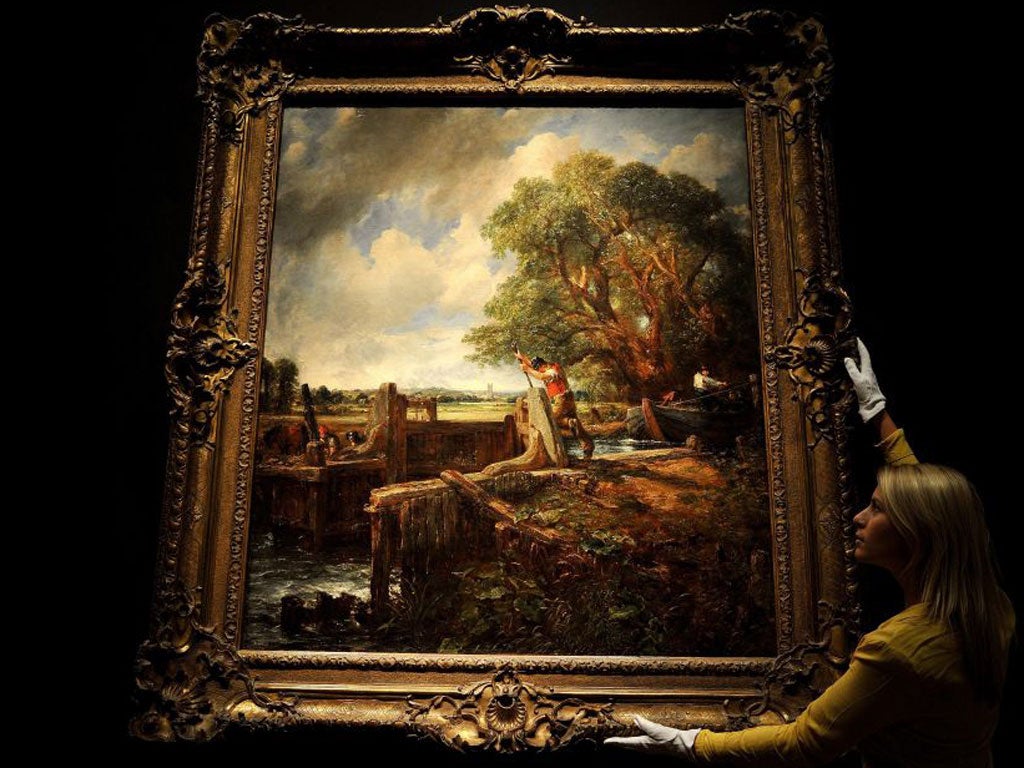The Lock, 1824, 142.2cm x 120.7cm, by John Constable
Private collection

Your support helps us to tell the story
From reproductive rights to climate change to Big Tech, The Independent is on the ground when the story is developing. Whether it's investigating the financials of Elon Musk's pro-Trump PAC or producing our latest documentary, 'The A Word', which shines a light on the American women fighting for reproductive rights, we know how important it is to parse out the facts from the messaging.
At such a critical moment in US history, we need reporters on the ground. Your donation allows us to keep sending journalists to speak to both sides of the story.
The Independent is trusted by Americans across the entire political spectrum. And unlike many other quality news outlets, we choose not to lock Americans out of our reporting and analysis with paywalls. We believe quality journalism should be available to everyone, paid for by those who can afford it.
Your support makes all the difference.John Constable developed his genius as a painter of the English scene by interrogating, over and over again, a tiny compass of the landscape of Suffolk whose details appear and re-appear in his paintings, quite obsessively: Flatford Mill, Dedham Lock and Mill, Dedham Church itself.
In this great work of 1824, which was sold at auction for £22.4m this week, we see once again the figure of the lock keeper who may already be familiar to us from an earlier painting called Dedham Lock and Mill. The Lock itself has its antecedents. There is both a preliminary oil sketch for the painting and a drawing of 1823, and when we look from these earlier efforts to the finished work, we see how his pictorial thinking, and his way of making, are developing, side by side. These are the paintings with which he appears to be beating at the doors of the Royal Academy, striving to legitimatise his practice as a painter, to prove that he can not only be faithful to the particular local landscape that he will memorialise life-long, but that he is capable of doing so in ways which will link him, immediately, to the great masters of the past, making him the natural heir of Claude, Ruisdael, Titian. They are paintings which give us solid proof of quite how much looking he was doing in these years of his increasing maturity.
In the earlier pencil and wash drawing of 1823, the keeper is a much more insignificant element of the scene altogether. We see him on the far side of the bank; he is altogether smaller, and set much lower. By the time Constable paints the full-size oil sketch, our sense of the importance of the presence of the man has changed utterly. Raised higher, and even a little elongated, he has evolved into a hero of labour whose presence might cause us to think back to the heroic gestures of mythological beings.
In The Lock itself, the lock-keeper stands central, pivotal, in a gesture of extreme manual effort. He leans into the crowbar, left knee raised, right foot on tiptoe. The quality of his physical struggle is enhanced by the way in which Constable has painted that great flourishing of trees at his back. These trees loom magnificently over the scene. They thrash like Titian's trees. Where exactly are they rooted though? In that meadow on the farther bank of the canal? It is not entirely clear to us. There is a wonderful trick of deception about the way he has painted these trees. We seem to be seeing them both abundantly foliaged and partially leafless – simultaneously. We see through as if to the heart of the trees, to the twisty, sinuous structure of their limbs – look at that gaping wound of a broken limb. All this contributes to a sense that a great straining is taking place – nature is working in sympathy with the keeper of the lock gate, replicating his efforts. But the trees do not strain up too far. They are not trees – as they might have been in a Titian – whose crowns reach as high as heaven. These trees stop short at troubled, earth-connected skies. They reach up no further than the broody, scudding clouds of a natural landscape. There is vigour too in the rough and energetic texture of this painting which, once again, adds to that sense that the underlying theme here is laboursomeness. Even the palette knife is pitching in, straining at the leash.
Constable was happy with this painting, twice over. He considered it to be an accomplished work, and he sold it almost immediately, to a stranger, for 150 pounds – somewhat less than it will achieve in the saleroom this week.
About the artist: John Constable (1776-1837)
John Constable was one of the defining painters of the English landscape, and a master of technical innovation. His paintings are lodged in our psyches as both naturalistic and nostalgically idealised representations of what this particular part of the English soil both is and for ever will be.
Join our commenting forum
Join thought-provoking conversations, follow other Independent readers and see their replies
Comments